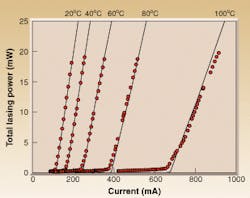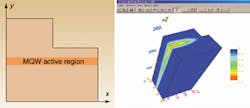Software and Computing: Simulation software gives laser designers insight
Z. SIMON LI and JOACHIM PIPREK
Recently there has been an increasing use of computer-aided-design (CAD) software for the development of semiconductor lasers in practical manufacturing environments. The key aim of such software is to understand and eliminate undesirable effects in existing devices and to optimize laser performance.
Undesirable effects include temperature sensitivity of lasing threshold and slope efficiency, transition from single-mode to multimode lasing, nonlinear light vs. current (L-I) characteristics, and lasing power saturation. A full understanding of these effects requires advanced laser-diode simulators, because the effects involve complex electronic, quantum-mechanical, optical, and thermal processes that interact with each other.
The commercial laser-diode simulators of Crosslight Software (Gloucester, Ont., Canada) have been successful in analyzing such effects. LASTIP is a two-dimensional simulator that includes multilateral mode capability.1 PICS3D is a three-dimensional simulator that includes a multiple-longitudinal-mode model.2 Both are capable of self-heating analysis. They offer rigorous and self-consistent treatments of electrical and optical processes by solving the appropriate partial differential equations.
An ideal CAD simulator should include all relevant physical processes and their interaction self-consistently. Major physical processes in laser diodes are described by differential equations, which are the theoretical basis of the software. The Schrödinger equation governs electrons and holes in quantum wells. The Poisson equation relates the electrical potential to the spatial charge distribution. The current-continuity equations describe the macroscopic carrier transport mechanisms (also known as the drift-diffusion model). The carrier-energy-balance equation represents the nonisothermal carrier transport. This is needed to model electron cooling and heating effects. The Maxwell equations govern the optical modes of the propagating waves.
Using the multilateral mode model in LASTIP, you can predict under what bias conditions lasing transfers from the main mode to a higher-order mode or modes. As higher modes start to dominate, it is likely that the optical loss or other properties are different from the main mode. As a result, an abrupt change (kink) in the L-I curve can be observed.
The software also calculates the nonuniformity of the carrier distribution in multiple-quantum-well (MQW) lasers. This nonuniformity increases with higher current and causes the net Auger recombination in long-wavelength MQW lasers to rise above threshold and to contribute to nonlinerarities of the L-I characteristic. This is in contrast to the common assumption that above lasing threshold, the Fermi levels and carrier densities remain unchanged (pinned) within the active layers. The software reveals that this assumption is not correct for MQW lasers, and it can explain the low differential internal efficiency that was measured in absence of leakage currents.3
The PICS3D also was used to study the accuracy of a popular experimental method for obtaining the internal optical loss and the internal differential efficiency of laser diodes.4 This method neglects the dependence of both parameters on the cavity length, leading to an overestimation of optical losses for short lasers.
Temperature effects
The heat-transfer model in both software packages includes the self-heating effects due to Joule heat and other heat sources in a semiconductor. In a simulation of continuous-wave lasing, the internal temperature increases with higher current and the optical gain degrades, causing the emission power to level off.
The high temperature sensitivity of long-wavelength lasers (1.3- to 1.55-µm) grown on indium phosphide can create severe performance limits in fiberoptic-communications applications. These effects have been studied for more than two decades, and the dominating physical mechanisms are still controversial. Among the proposed causes are Auger recombination, intervalence band absorption, thermionic carrier emission, lateral carrier spreading, passive layer absorption, spontaneous recombination within passive layers, and optical gain reduction. Without a self-consistent model that can take into account all of these mechanisms, it was very difficult to accurately evaluate the importance of each mechanism. One-sided models led to one-sided interpretations of measurements and contributed to the controversy.
Using PICS3D, researchers at the University of California at Santa Barbara (UCSB; Santa Barbara, CA) recently have analyzed the temperature dependence of 1.55-µm lasers.5 Experimental results in pulsed operation were obtained from Fabry-Perot lasers containing a compressively strained indium gallium arsenide phosphide MQW active region. A substantial increase in threshold current and a reduction in L-I slope efficiency are measured with higher temperature. The self-consistent inclusion of all relevant physical mechanisms in the software results in an excellent agreement between simulation and experiment over a wide temperature range (see Fig. 1). Such a comprehensive agreement is required to draw valid conclusions from the simulation. The successful fit to measurements was achieved by fine-tuning of key material parameters like Auger and absorption coefficients.
The software contains a large database of default parameters for each material, including temperature dependence. Actual numbers may vary, however, depending on the device technology, and crucial parameters need to be adjusted.
Once a full agreement with experiments was achieved, different physical mechanisms were analyzed so that a clear answer could be given to the long-argued causes of high temperature sensitivity. In the lasers investigated, Auger recombination was found to control the threshold current below about 100°C. At higher temperatures, vertical electron leakage from the p-side separate confinement layer mainly limits the laser performance. Intervalence band absorption is less important. All the carrier and photon loss enhancements with higher temperature are mainly triggered by the reduction of optical gain due to a wider electron energy distribution or electrons. This gain reduction must be compensated for by higher carrier density (higher current), which leads to higher Auger recombination and more leakage current. The flexibility of the software made it possible to turn on or off each of these mechanisms and to study their exact contribution. As a result, many physical variables—such as carrier concentration, distribution of current, and all types of carrier recombination rates—can be plotted and analyzed (see Fig. 2).Research results from UCSB and other groups show that the availability of sophisticated commercial laser simulators makes it possible for laser design engineers to analyze and understand their devices in great detail and to gain insight into performance limitations.6,7 Previously, such analysis was the domain of a few theoretical laser-research groups. Now, anyone with a modest background in laser physics can apply commercial simulators to real-world problem solving and device optimization.
REFERENCES
- S. Li, Y. Wu, and R. Rambaran, Laser Focus World 32(11), 233 (Nov. 1996).
- Z. Simon Li, Laser Focus World 33(5), 251 (May 1997).
- J. Piprek, P. Abraham, and J. E. Bowers, Appl. Phys. Lett. 74, 489 (Jan. 1999).
- J. Piprek, P. Abraham, and J. E. Bowers, IEEE J. Selected Topics in Quant. Electron. 2(5), 643 (May 1999).
- J. Piprek, P. Abraham, and J. E. Bowers, IEEE J. Quantum Electronics, in press.
- Y. Yoshida et al., IEEE J. Quant. Electron. 34(7), 1257 (July 1998).
- K. Domen et al., MRS Internet J. Nitride Semiconductor Res. 3, art. 2; nsr.mij.mrs.org (1998).
Z. Simon Li is president of Crosslight Software Inc., POB 27102, Gloucester, Ontario, Canada K1J 1A8; e-mail: [email protected]. Joachim Piprek is a research professor in the electrical and computer engineering department, University of California, Santa Barbara, CA 93106; e-mail: [email protected].

